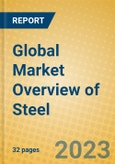The briefing examines how the steel commodity is performing globally and in the largest countries in terms of supply and production. The report also provides data and analysis on steel price dynamics, as well as trends across key commodity consuming industries.
Strategy Briefings offer unique insight into emerging trends world-wide. Aimed squarely at strategists and planners, they draw on the vast information resources to give top line insight across markets and within consumer segments. Written by some of our most experienced analysts, they are designed as provocations for senior management to use in their own forum, allowing them to stand back and reflect on the behaviour and motivation driving global markets today and tomorrow
Data coverage: Market sizes (historic and forecasts), company shares, brand shares and distribution data.
Key Findings
Steel prices peaked in 2022
Steel prices stabilised in 2023, as countries found alternative supply to replace losses from the Russian and Ukrainian markets. Moreover, Chinese trade limitations related to its previous zero-COVID-19 policy have been lifted, allowing the largest global steel producer to utilise its production on the global market, although the country continues to seek to reduce production.
Construction to slow down as subsidies are phased out and inflation rises
The construction sector was the key driver of the steel demand boom in 2021; however, the phasing out of subsidies, increased uncertainties, rising essential commodities prices and a projected rise in borrowing costs are anticipated to lead to slower residential construction demand over the forecast period.
Cooling of construction market to be compensated for by recovering machinery demand
Machinery demand grew after the COVID-19 pandemic, as industrial activities picked up. Moreover, automation is becoming a significant area of investment as companies deal with labour shortages and aim to mitigate the risks of potential future shutdowns due to virus spread, as occurred during the pandemic. Moreover, given the looming food crisis due to Russia’s invasion of Ukraine, agricultural machinery is expected to gain momentum as countries aim to boost productivity and yields.
Sustainability, decarbonisation and circular economy on the agenda
Rising emissions permit costs, increasing pressure from society and government regulations are pushing the carbon-intensive steel industry to seek solutions to reduce its carbon footprint. Sustainability is projected to become an important trend in the industry over the long term. Companies are expected to invest in the recycling of scrap metal waste in order to reduce the negative environmental impact of their production.
Why buy this report?
- Identify factors driving change now and in the future
- Understand motivation
- Forward-looking outlook
- Briefings and presentation should provoke lively discussion at senior level
- Take a step back from micro trends
- Get up to date estimates and comment








